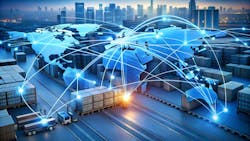With the reality of tariffs on China, and soon to be implemented on Canada and Mexico, companies are re-examining their supply chains.
A few days before the finalization of the tariff policy, MH&L talked with Travis Epp, a CPA and partner in charge of the Manufacturing and Distribution Group at Eisner Advisory Group, LLC, about what advice he would give to companies given the new trade landscape.
MHL: A survey from the Conference Board found that 71% of CEOs are planning to alter their supply chains, but how quickly will they be able to react to potential new tariffs?
TE: With their knowledge gained from dealing with the pandemic, they will be able to act fairly quickly. However, it may take a period of time for those actions to affect the bottom line.
Since the election, some companies have decided to accelerate their imports, in anticipation of the tariffs. This, of course, works for companies that have the storage and the credit to finance this inventory.
In general companies are more proficient in supply chain management as a result of dealing with the pandemic. It highlighted where there were weaknesses in the supply chain. Consequently, as part of their responsibility and oversight for their business, CEOs became very familiar with their supply chains and are able to react to disruptions. Those disruptions can be a bridge collapsing, strikes at ports and of course tariffs.
MHL: Given companies are unable to constantly change their supply chains due to changes in politics, do they see reshoring and nearshoring as long-term solutions?
TE: I think companies should be able to constantly review their supply chain.
Nearshoring has become more prevalent, as both Mexico and Canada are the largest trade partner of the US. However, with the proposed tariffs, it might create challenges for nearshoring and companies may choose alternatives that would be more cost competitive.
When considering reshoring, a company has to look at the overall economics of bringing manufacturing facilities back to the US. While the concept is appealing as it creates jobs, the labor costs are still higher in the US and there are challenges of building in the US. One issue is that some states are more business-friendly than others. And environmental concerns play a big part in how successful reshoring can be.
If you look at the last administration, they were able to drive certain actions through tax policy. If President Trump reduces taxes on manufacturing businesses in the US, that could assist in reshoring of US business.
MHL: Even as companies localize supply chains, there are many components that are not produced in the US and would take years to set up production facilities. What advice do you offer in those cases?
TE: Make sure that you clearly understand your supply chain and that includes current, future and alternative vendors. It's critical to maintain various options for your most critical raw materials. Sources need to be in the US and global as this will provide greater flexibility as well as assist in price and volume negotiations.
Overall, manufacturing has changed its production mix. In the past some companies might have done all of their manufacturing offshore. But now it's more of a mix. Some manufacturing is done overseas and then the light manufacturing, and assembly is done in the US, so this might lessen the exposure to tariffs.
When moving parts of the manufacturing process to the US, companies must review the specific characteristics of each state. For example, what is the transportation and logistics structure? Is the labor pool compatible with the company's needs? What are the state and local taxes?
MHL: A recent survey from the World Economic Forum is pointing to Vietnam, and UAE as supply chain safe havens, given they are non-aligned countries. Do you see production expanding there? What other countries do you see as becoming a part of the new supply chain?
TE: In the last number of years, even going back to the first Trump administration when tariffs were levied against China, companies did move their supply chains to Vietnam. I think that will continue for many years as challenges with China will continue.
The US and the UAE are expanding their trade relationship. The US has a trade surplus with the UAE and that will expand, but it will take some time for that to have a meaningful impact in the US.
With regard to what countries US manufacturing will add production, I look at it differently. Instead of asking what countries can be new trade partners, I would ask what are the raw material for products that have been in short supplies and which countries do we need to have trade relationships with in order to source those materials.
For example, as we push for a green economy including electric vehicles and more solar power, we discovered that there is a shortage of critical minerals for these industries including lithium and cobalt. Rather than focus on the countries, we should focus on the raw materials we need and that will determine our trade partners.
MHL: What advice would you offer for companies trying to plan their supply chains three to five years out?
TE: Disruptions will always occur, but we are in a much better place now, having gone through the extreme disruption caused by the pandemic. We have more information now and are more aware of alternative sourcing, so that will serve us well as we plan for the future.
As the world changes, the product mix will change so plan your supply chain in advance.
As you plan in the future, even though we are focused on the bottom line, it may be more important from a business strategy to look at an alternative source of materials, even with a short- term sacrifice to profits.
My basic advice is know your supplies chain, know your vendors, and know who your alternative vendors are around the world.
About the Author

Adrienne Selko
Senior Editor
http://mhlnews.com
Adrienne Selko is also the senior editor of EHS Today and a former senior editor of IndustryWeek.
